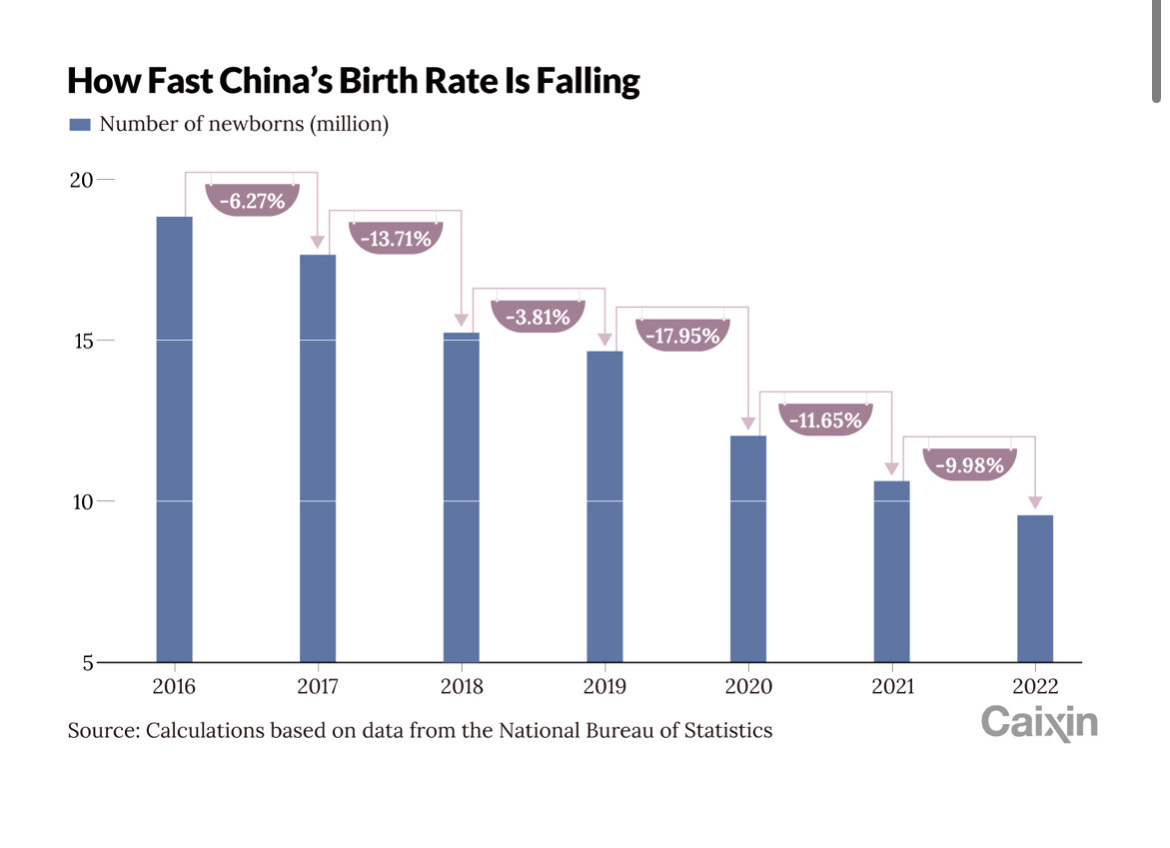The baby bust is worsening
Birth rates in many countries fell over 10 percent from 2021 to 2023. The mRNA Covid jabs don't seem to be the culprit. Some nations that heavily used them saw large declines, but they were not alone.
At this rate no one is going to be around to replace anyone else.
From Asia to Europe to the Americas, across nations and races and religions, birth rates plunged again in 2023.
Countries across the developed world are having kids at levels far too low to keep their populations steady. Women must have about 2.1 children on average to maintain a stable population. But many wealthy and even middle-income countries are now below 1.5 kids per woman. Some are under 1, heralding demographic collapse.
Birth rates have been slowly falling for a while. But last year’s drops were notable both for their severity and because they’re now happening sharply in countries that had largely avoided them, such as France. The United States is a striking exception. American births fell only about 2 percent in 2023, to roughly 3.6 million.
(To find out where the problem is worst, subscribe.)
The baby bust is most severe in East Asia, and China in particular.
Newly leaked data reveals that China recorded fewer than 8 million births in 2023. If that figure is confirmed, it will represent a decline of 17 percent from 2022, and an unfathomable drop of almost 60 percent since 2016.
Yes, you read that correctly.
In 2016, China - which has about 1.4 billion people - reported 18.8 million births, according to Caixin, a Beijing-based investigative magazine. (Although every Chinese news organization faces government censorship, Caixin is still reasonably reliable.)
But by 2019, even before Covid and China’s harsh lockdowns, births had fallen to 14.7 million. Since then, they have plunged even faster. By one estimate, China had fewer children born in 2022 than it did in 1790.
—
(Zero-child policy.)
—
Sociologists and political scientists have blamed China’s worsening political repression and its slowing economic growth for the sudden baby bust.
But China, which is far richer than it was a generation ago, is also simply falling in line with smaller East Asian neighbors like Taiwan and Singapore. Those countries have had low fertility rates for decades, yet their birth rates are still falling.
The East Asian baby bust is not limited to ethnic Chinese, either. Women in Thailand and Japan now have an average roughly 1.2 children. And South Korea, the world leader in this unfortunate limbo, hit a record low of about 0.7 children per woman. South Korea has almost 52 million people. Women there had roughly the same number of births in 2023 as Florida, which has just over 22 million.
—
—
Births are plunging in Europe, too, particularly in northern European countries such as France, which had posted relatively high fertility rates - in part because of Muslim immigrants. Across a swath of Europe from Ireland to Germany to Finland, births are down more than 10 percent in the last two years, with women now expected to have roughly 1.3-1.5 children on average. (France is still slightly higher.)
About the only marginally good news is that birth rates are declining more slowly in Southern Europe. But declining they are, and from a low base. Italy and Spain are both in the 1.1-1.2 child per woman average.
—
Governments are increasingly aware of the fertility crisis. Many countries have done far more than the United States to offer financial help to families with young children.
Northern European nations like Sweden also aggressively protect women who have kids from workplace discrimination, and France is known for its excellent highly subsidized child care.
But the direct credits or cash payments seem to make little difference, and the plunging fertility rates in northern Europe suggest that even good child care is no longer enough to entice women on the bubble to have children.
Meanwhile, the United States still has relatively high fertility levels among advanced nations, though it too has seen a slow decline.
As for the mRNA jabs, the worldwide and synchronized drop in births suggests they are probably not to blame. So does the fact that China, which did not use them, saw among the biggest decreases since 2021. Meanwhile, southern European countries and the United States, which did, have seen relatively small declines.
As upsetting as an mRNA-driven fertility decline might be, at least then the world would have an explanation, and a target to fix. Instead a combination of cultural and economic factors - possibly accelerated by declines in male or female fertility - seems to be driving the bust.
And the problem is only getting worse.







Hopelessness. Loss of faith in God and in ones future. Global warming pessimism beat into kids heads from birth. Crazy long term increases in cost to live (housing) and educate kids. Growth in alternatives for women while, simultaneously, men are losing their sense of purpose. So many contributing factors. Makes me sad as a father of 3 --it’s is the great joy of my life to be called dad with respect and affection.
Devalue the full time job of Mother and this is what you get.